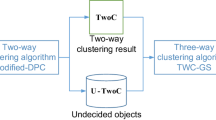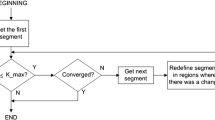Abstract
In pattern recognition, patterns are described in terms of features. The features form feature vectors in the feature space. In the light of the phenomenon of gravitation in star clusters, we define patterns in the feature space to self-organize into clustering networks called “vector gravitation clustering networks” in this study. In the proposed clustering method, one called “vector gravitational force” is employed for the similarity measure in the feature space. Then by means of the “vector gravitational force”, patterns self-organize clustering networks called “vector gravitation clustering networks” in the feature space. The proposed clustering method is applied to experiments. The experimental results show workability of the proposed clustering method. It is revealed that patterns tend to have more called “vector gravitational force” between ones of the same categories than between ones of the different categories in the feature space. Finally, further performance analysis employing the ANOVA (“analysis of variance”) and the Newman-Keul procedure indicates potentiality of the proposed clustering method. As being inspired by the phenomenon of gravitation in star clusters and by using the “vector gravitational force” for similarity measure, “interpretability” is one obvious advantage of the proposed clustering method, and it may be viewed as one natural clustering method.








Similar content being viewed by others
References
Alok, A. K., Saha, S., & Ekbal, A. (2015). Semi-supervised clustering for gene-expression data in multiobjective optimization framework. International journal of machine learning and cybernetics. https://doi.org/10.1007/s13042-015-0335-8.
Ansari, M. Y., Ahmad, A., Khan, S. S., Bhushan, G., & Mainuddin. (2019). Spatiotemporal clustering: A review. Artificial Intelligence Review, 1–43. https://doi.org/10.1007/s10462-019-09736-1.
Brandstein, M., & Ward, D. (2001). Microphone arrays. Springer-Verlag.
Chen, S. G., & Wu, J. Y. (2005). A geometric interpretation of weighted normal vectors and its improvements. In: Proceedings international conference on computer graphics, imaging and visualization (pp. 422–425).
Chen, C. Y., Hwang, S. C., & Jen Oyang Y. J. (2002). An incremental hierarchical data clustering algorithm based on gravity theory. In Proc. PAKDD 2002, lecture notes in computer science (vol. 2336, pp. 237–250). Springer.
Chung, K. L., & Lin, J. S. (2007). Faster and more robust point symmetry-based K-means algorithm. Pattern Recognition, 40(2), 410–422.
Cong, Z., Fernandez, A., Billhardt, H., & Lujak, M. (2015). Service discovery acceleration with hierarchical clustering. Information Systems Frontiers, 17(4), 799–808.
Duda, R. O., Hart, P. E., & Stork, D. G. (2004). Pattern classification (2nd ed.). Beijing: Wiley, China Machine Press.
Ellis, D. (2005). Lecture 3: pattern classification http://www.ee.columbia.edu/~dpwe/e6820/ EE E6820: Speech & Audio Processing & Recognition.
Haykin, S. (2001). Neural networks: a comprehensive foundation (2nd ed.). Beijing: Prentice-Hall Inc. and Tsinghua University Press.
Hu, J., & Pei, J. (2018). Subspace multi-clustering: a review. Knowledge and information systems, 56(2), 257–284.
Hussain, A., & Cambria, E. (2018). Semi-supervised learning for big social data analysis. Neurocomputing, 275, 1662–1673.
Jain, A. K., Mutry, M. N., & Flynn, P. J. (1999). Data clustering: A review. ACM Computing Surveys, 31(3), 264–323.
Matteucci, M. (2007). A tutorial on clustering algorithms: Introduction to clustering. http://home.dei.polimi.it/matteucc/Clustering/tutorial_html/index.html.
Nilsson, N. J. (2005). Introduction to machine learning, artificial intelligence laboratory, Stanford University. http://ai.stanford.edu/people/nilsson/mlbook.html.
Oktar, Y., & Turkan, M. (2018). A review of sparsity-based clustering methods. Signal processing, 148, 20–30.
Oyang, Y. J., Chen, C. Y., & Yang, T. W. (2001). A study on the hierarchical data clustering algorithm based on gravity theory. In Proc. PKDD 2001, Lecture notes in computer science (Vol. 2168, pp. 350–361). Springer.
Queiroga, E., Subramanian, A., & Lucídio dos Anjos, F. C. (2018). Continuous greedy randomized adaptive search procedure for data clustering. Applied soft computing, 72, 43–55.
Rahman, M. A., & Islam, M. Z. (2018). Application of a density based clustering technique on biomedical datasets. Applied soft computing, 73, 623–634.
Rokach, L. (2010). A survey of clustering algorithms. In: O. Maimon, L. Rokach (eds.), Data mining and knowledge discovery handbook (pp. 269–298). Springer Science +Business Media, LLC.
Saxena, A., Prasad, M., Gupta, A., Bharill, N., Patel, O. P., Tiwari, A., Er, M. J., Ding, W., & Lin, C.-T. (2017). A review of clustering techniques and developments. Neurocomputing, 267, 664–681.
Schreiber, I., & Ben-Bassat, M. (1990). Polygonal object recognition. In: Proceedings of the 10th international conference on pattern recognition (pp. 852–859).
SEDS (Students for the Exploration and Development of Space). (2007). Star Clusters. http://seds.org/messier/cluster.html.
Shawe-Taylor, J., & Cristianini, N. (2004). Kernel methods for pattern analysis. Cambridge University Press.
Silva, A., & Antunes, C. (2012). Semi-supervised Clustering: a case study. Lecture Notes in Computer Science, 7376, 252–263.
Tang, W., Xiong, H., Zhong, S., & Wu, J. (2007). Enhancing semi-supervised clustering: a feature projection perspective. International Conference on Knowledge Discovery and Data Mining (SIGKDD), pp. 707–716.
Theodoridis, S., & Koutroumbas, K. (2009). Pattern recognition (4th ed.). Beijing: Elsevier and China Machine Press.
UCI Machine Learning. (2017). UCI Machine Learning Database. ftp://ftp.ics.uci.edu/pub/machine-learning-databases.
UT Astrophysics. (2007). Star Clusters. http://csep10.phys.utk.edu/guidry/violence/starclusters.html.
Yang, Z.-C. (2008). A vector gravitational force model for classification. Pattern Analysis & Applications, 11(2), 169–177.
Yang, Z.-C., Kuang, H., Xu, J.-S., & Sun, H. (2016). Credit evaluation using Eigenface method for Mobile telephone customers. Applied Soft Computing, 40, 10–16.
Zhou, S., & Xu, Z. (2018). A novel internal validity index based on the cluster Centre and the nearest neighbour cluster. Applied soft computing, 71, 78–88.
Zhu, X. J. (2008). Semi-supervised learning literature survey (pp. 1–60). Computer Sciences, University of Wisconsin-Madison.
Zhu, E., & Ma, R. (2018). An effective partitional clustering algorithm based on new clustering validity index. Applied soft computing, 71, 608–621.
Acknowledgments
The research was supported by “Scientific Research Fund of Hunan Provincial Science and Technology Department (2013GK3090)”.The authors are also very grateful to the UCI Knowledge Discovery and the UCI Machine Learning website. Many thanks also to the donors: Michael Marshall, Dr. WIlliam H. Wolberg, Olvi Mangasarian, Doug Fisher, Vision Group (Carla Brodley), Richard S. Forsyth, and to the many unmentioned others. The author would also like to extend his appreciation to the editor(s) and anonymous reviewers for their valuable comments and suggestions.
Author information
Authors and Affiliations
Corresponding author
Additional information
Publisher’s Note
Springer Nature remains neutral with regard to jurisdictional claims in published maps and institutional affiliations.
Rights and permissions
About this article
Cite this article
Yang, Zc. Vector Gravitation Clustering Networks. Inf Syst Front 23, 695–707 (2021). https://doi.org/10.1007/s10796-020-09986-3
Published:
Issue Date:
DOI: https://doi.org/10.1007/s10796-020-09986-3




